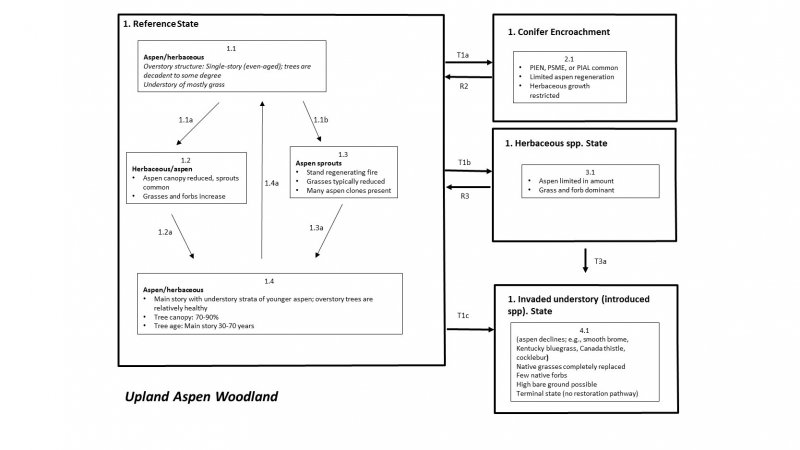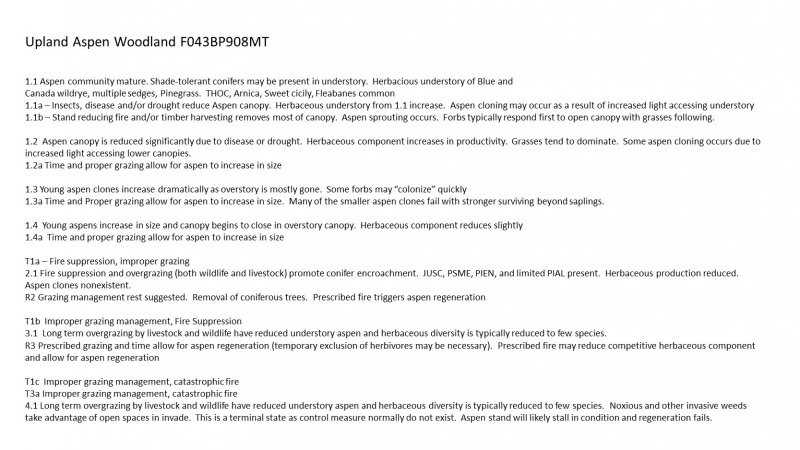
Natural Resources
Conservation Service
Ecological site F043BP908MT
Upland Aspen Woodland Group
Last updated: 3/01/2024
Accessed: 12/20/2025
General information
Provisional. A provisional ecological site description has undergone quality control and quality assurance review. It contains a working state and transition model and enough information to identify the ecological site.
MLRA notes
Major Land Resource Area (MLRA): 043B–Central Rocky Mountains
The Central Rocky Mountains (MLRA 43B) of Montana occupy some 28,850 square miles and exist primarily in Central and SW portions of the state. The climate is extremely variable with precipitation lows of 9 to 100 inches per year and frost free days of less than 30 to over 110 days. The geology of the region is also highly variable. The combination of variable climate and geology create a complex relationship of plant communities. MLRA 43B elevations typically exist between 6000 and 12,799ft at Granite Peak (the highest point in Montana).
The Continental Divide runs through this MLRA effectively splitting its watershed to contribute to either the Missouri River to the East and the Columbia River to the West.
Ecological site concept
• Site receives additional moisture
• Dominant Cover: Deciduous Forest
• Soils are
o Generally not saline or saline-sodic (limited extent)
o Moderately deep, deep, or very deep
o Typically less than 5% stone and boulder cover (<15% max)
• Soil surface texture ranges from sandy loam to clay loam in surface mineral 4”
• Site landforms: Hillslopes
• Moisture Regime: ustic to udic
• Temperature Regime: frigid to cryic
• Elevation Range: 4800-8200ft (typically less than 7000)
• Slope: 5-40% (typically less than 25%)
Associated sites
| R043BP818MT |
Upland Grassland Group Upland Grassland is often a neighboring site that can exist at the same landscape position. The Upland Grassland may be encroached by Aspen Woodland expansion. |
|---|---|
| R043BP819MT |
Upland Sagebrush Shrubland Group Upland Sagebrush Shrubland is often a neighboring site that can exist at the same landscape position. The Upland Sagebrush Shrubland may be encroached by Aspen Woodland expansion. |
| R043BP820MT |
Upland Shrubland Group Upland Shrubland is often a neighboring site that can exist at the same landscape position.. The Upland Shrubland may be encroached by Aspen Woodland expansion. |
| F043BP909MT |
Upland Cold Woodland Group Upland Cold Woodland is often a neighboring site that can exist at the same landscape position though commonly exists slightly higher on the landscape. The Upland Cold Woodland typically exists on linear or convex sites while the Upland Aspen Woodland tends to exist on a slightly concave site and on toe slopes. |
| F043BP910MT |
Upland Cool Woodland Group Upland Cool Woodland is often a neighboring site that can exist at the same landscape position though commonly exists slightly higher on the landscape. The Upland Cool Woodland typically exists on linear or convex sites while the Upland Aspen Woodland tends to exist on a slightly concave site and on toe slopes. |
| F043BP911MT |
Upland Warm Woodland Group Upland Warm Woodland is often a neighboring site that can exist at the same landscape position though commonly exists slightly higher on the landscape. The Upland Warm Woodland typically exists on linear or convex sites while the Upland Aspen Woodland tends to exist on a slightly concave site and on toe slopes. |
Similar sites
| R043BP801MT |
Bottomland Group Bottomland is the closest similar site within MLRA 43B. The two sites are both dominated by deciduous trees and may have overlapping understory vegetation however the two sites have distinctly different state and transition models and hydrologic processes. |
|---|
Table 1. Dominant plant species
| Tree |
(1) Populus tremuloides |
|---|---|
| Shrub |
(1) Symphoricarpos albus |
| Herbaceous |
(1) Calamagrostis rubescens |
Click on box and path labels to scroll to the respective text.

